Concave swimming pool panel
Foster , et al. July 9, 2
U.S. patent number 10,344,490 [Application Number 14/629,129] was granted by the patent office on 2019-07-09 for concave swimming pool panel. This patent grant is currently assigned to Trojan Leisure Products, LLC. The grantee listed for this patent is Trojan Leisure Products, LLC. Invention is credited to Charles M. Foster, Collin J. Sirco, David A. Steele.

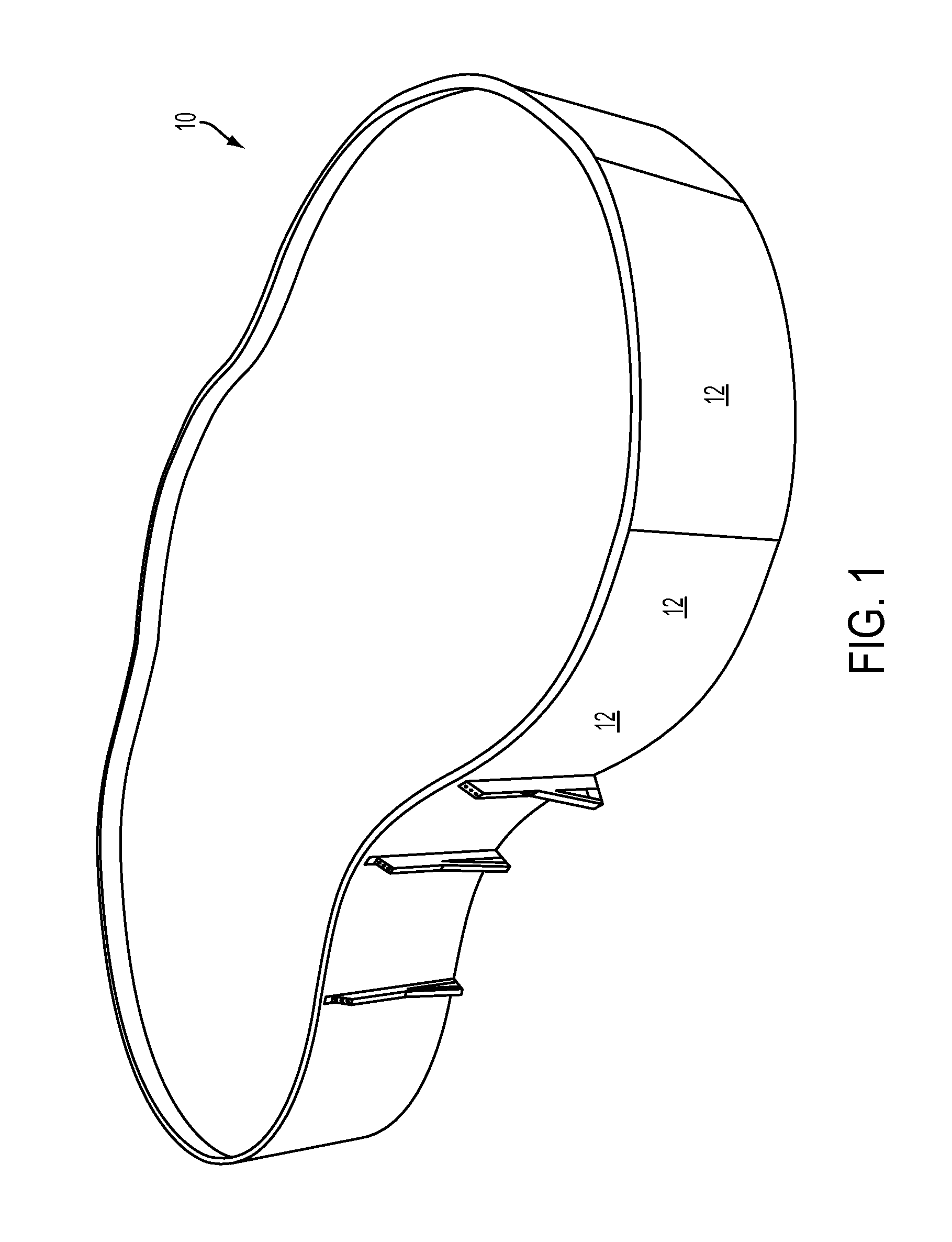
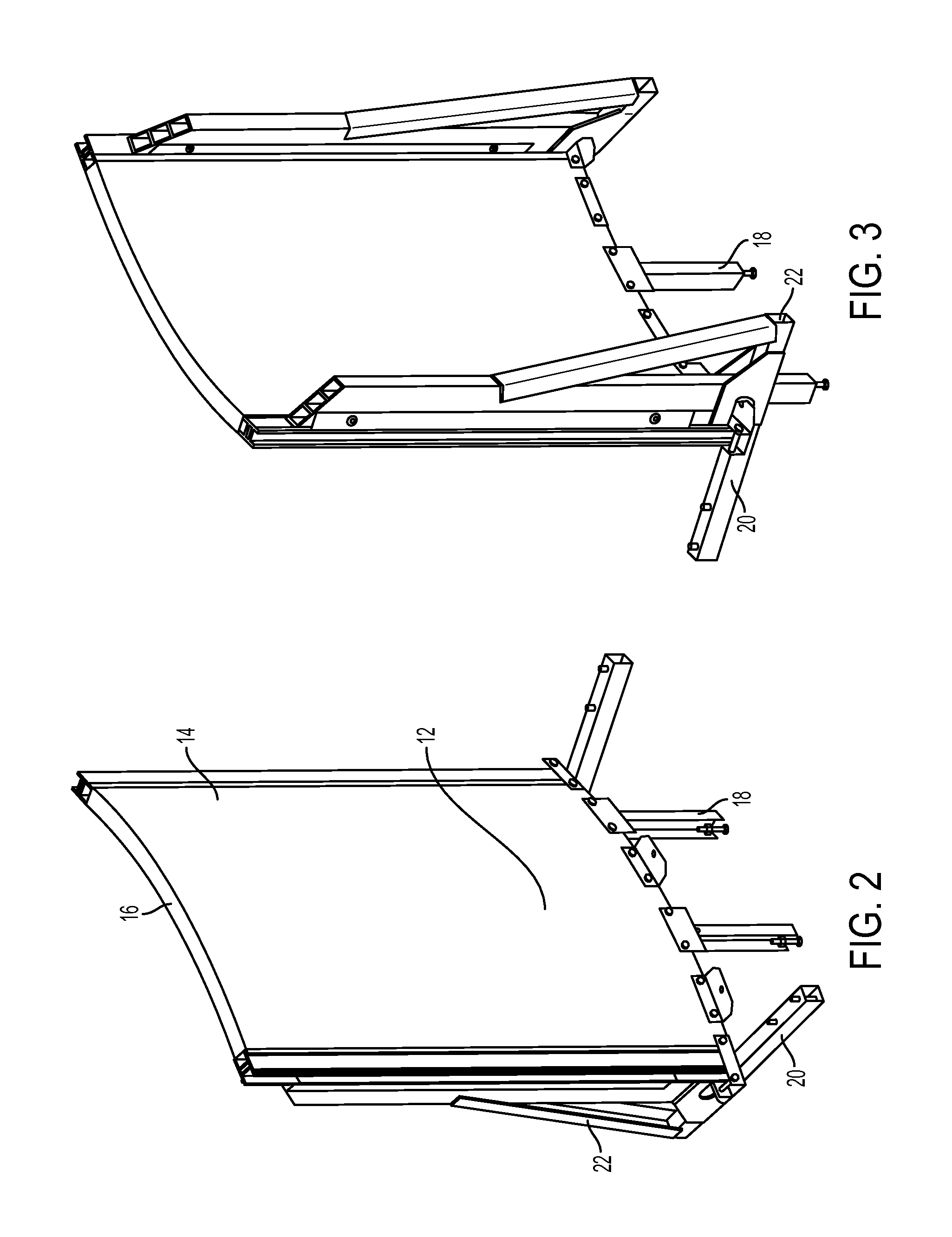
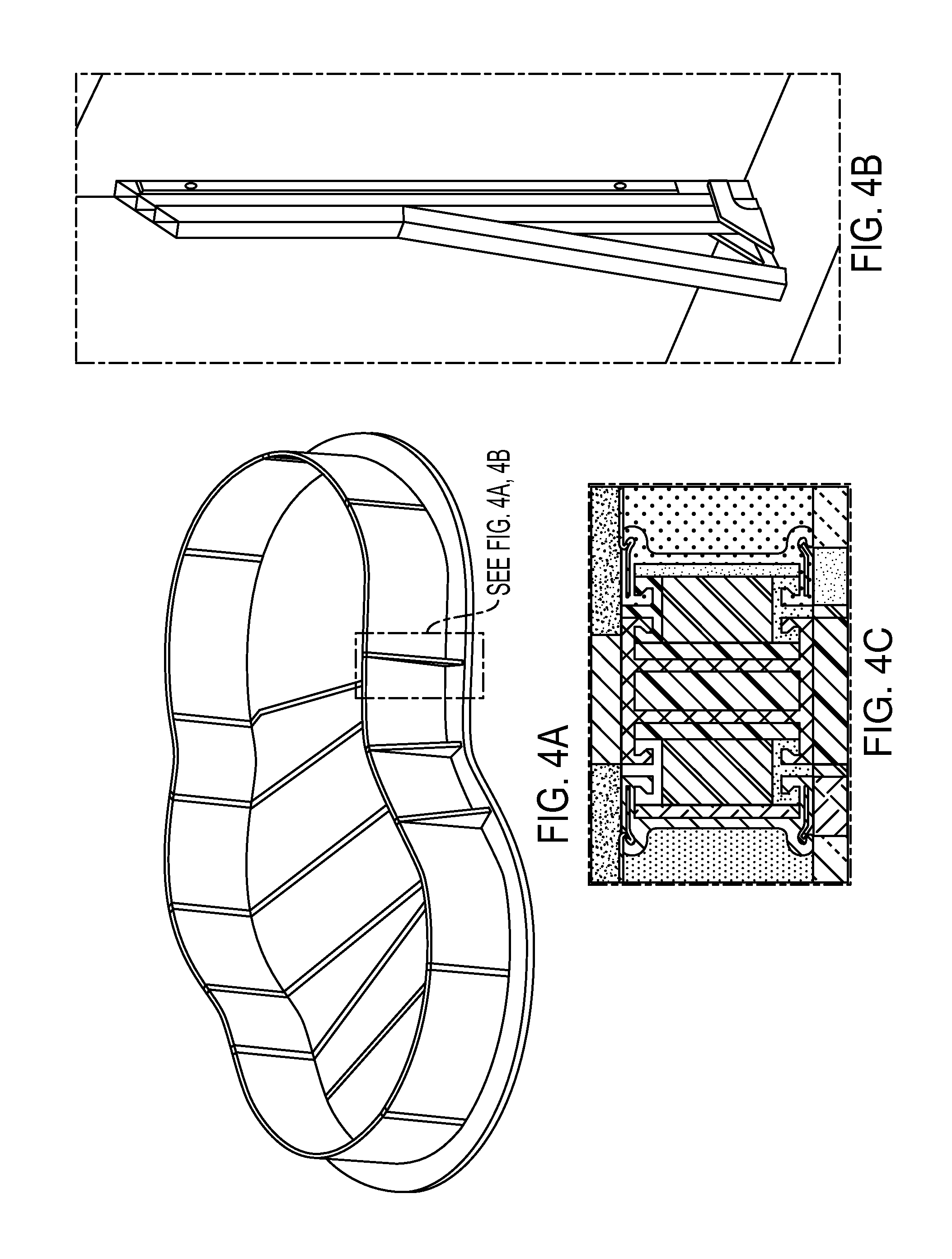

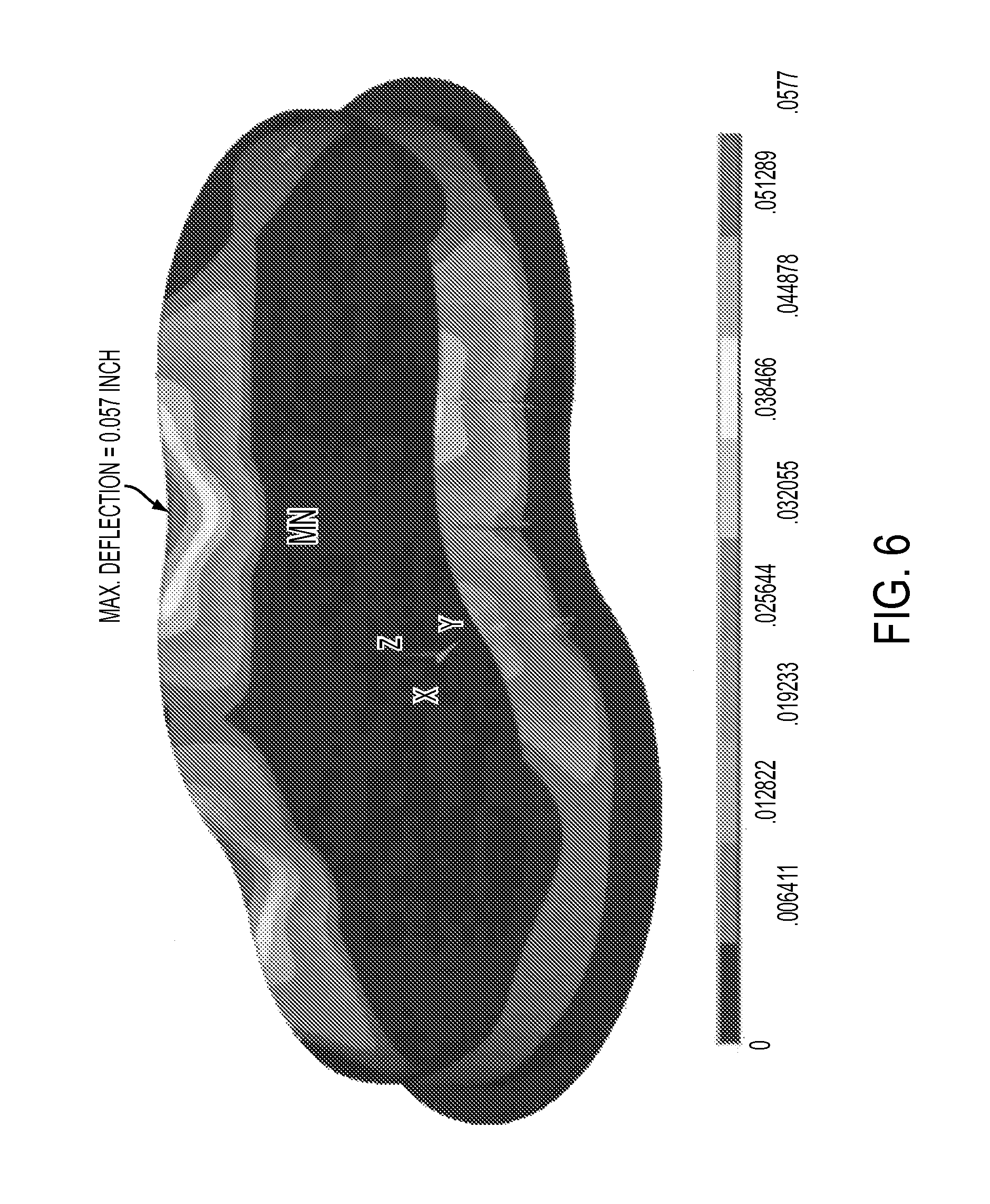
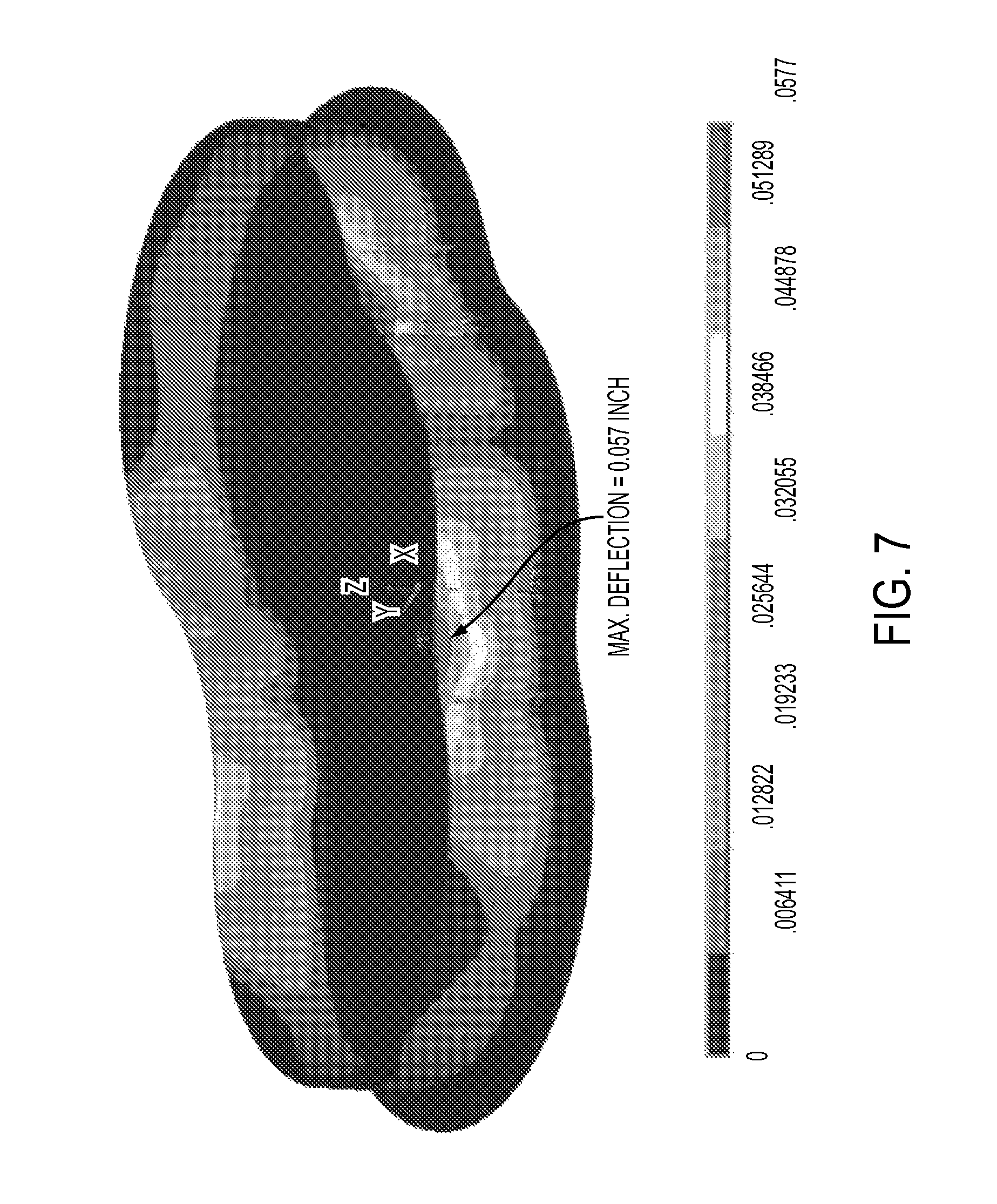
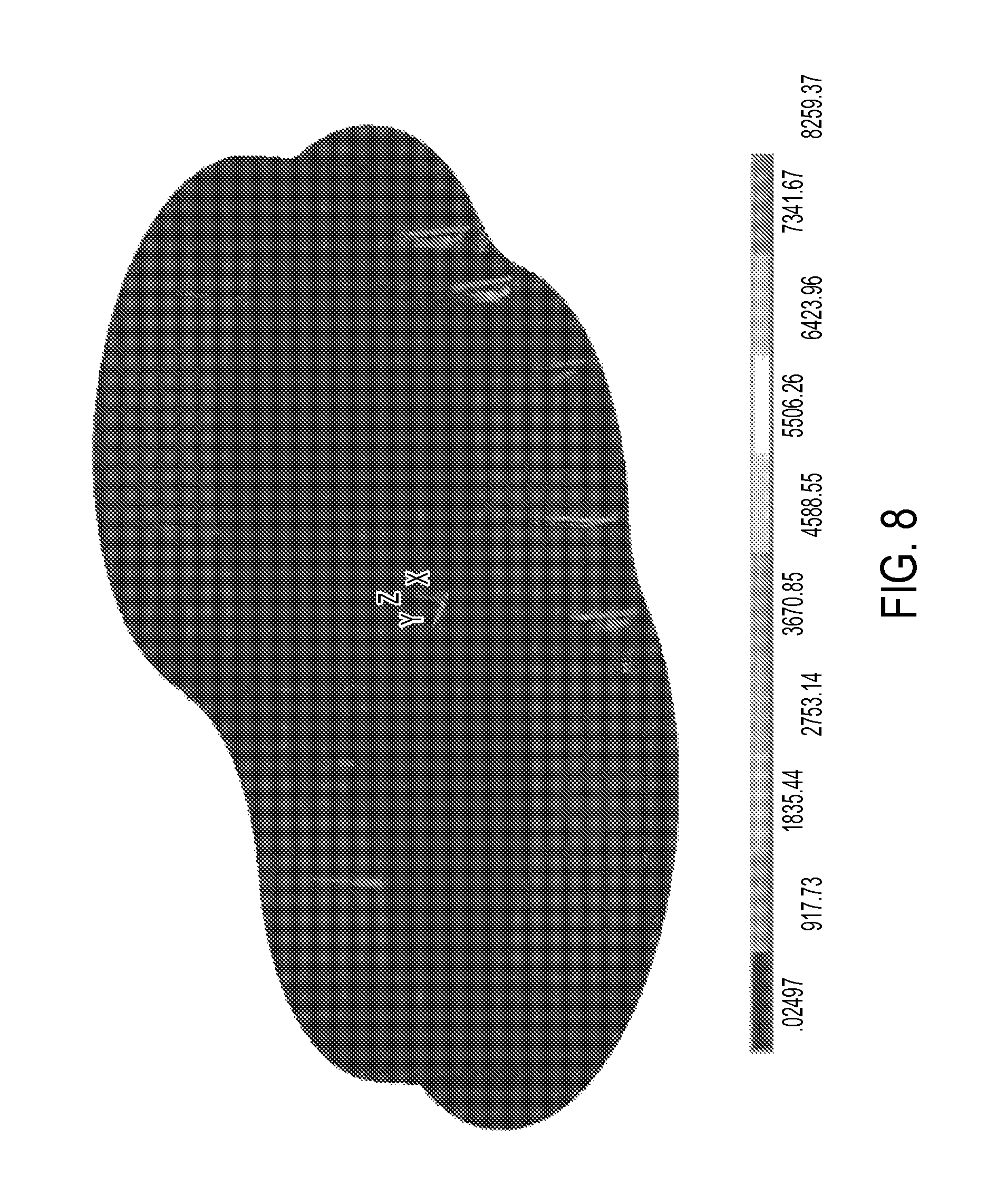




View All Diagrams
| United States Patent | 10,344,490 |
| Foster , et al. | July 9, 2019 |
Concave swimming pool panel
Abstract
A swimming pool consisting of a plurality of panels that withstands water pressure in both a concave and convex configuration to create any freeform shape or size. Each panel consists of an adhered wall of skinning of metal or plastic over expanded polystyrene or expanded urethane foam. The density of the foam is adjusted as necessary to increase the strength of the wall based on static loading of water when swimming pool is assembled as a whole and fully filled with water.
| Inventors: | Foster; Charles M. (Schenectady, NY), Steele; David A. (Gansevoort, NY), Sirco; Collin J. (Ballston Lake, NY) | ||||||||||
|---|---|---|---|---|---|---|---|---|---|---|---|
| Applicant: |
|
||||||||||
| Assignee: | Trojan Leisure Products, LLC
(Albany, NY) |
||||||||||
| Family ID: | 51221416 | ||||||||||
| Appl. No.: | 14/629,129 | ||||||||||
| Filed: | February 23, 2015 |
Related U.S. Patent Documents
| Application Number | Filing Date | Patent Number | Issue Date | ||
|---|---|---|---|---|---|
| 14165264 | Jan 27, 2014 | ||||
| 61756722 | Jan 25, 2013 | ||||
| Current U.S. Class: | 1/1 |
| Current CPC Class: | E04H 4/0043 (20130101); E04H 4/005 (20130101) |
| Current International Class: | E04H 4/00 (20060101) |
| Field of Search: | ;52/127.2,167.7,169.8,169.7 ;4/506,513 |
References Cited [Referenced By]
U.S. Patent Documents
| 3142069 | July 1964 | O'Connell et al. |
| 3274621 | September 1966 | Diemond et al. |
| 3298038 | January 1967 | O'Connell et al. |
| 3443263 | May 1969 | Minasy |
| 3518705 | July 1970 | Cudney |
| 3530512 | September 1970 | McBride |
| 3593348 | July 1971 | Toerge et al. |
| 3974605 | August 1976 | Beatty et al. |
| 3975874 | August 1976 | Witte |
| 4047340 | September 1977 | Witte et al. |
| 4055922 | November 1977 | Ellington et al. |
| 4464802 | August 1984 | Glonek et al. |
| 4501100 | February 1985 | Corna et al. |
| 4566141 | January 1986 | Mahoney |
| RE32181 | June 1986 | Glonek et al. |
| 4782538 | November 1988 | Chisholm et al. |
| 5325644 | July 1994 | Cornelius |
| 5522188 | June 1996 | Cornelius |
| 5875500 | March 1999 | Shaanan et al. |
| 5884347 | March 1999 | Yurchision et al. |
| 6378144 | April 2002 | Yurchision |
| 6421846 | July 2002 | Shaanan et al. |
| 6782668 | August 2004 | Bruce |
| 7739842 | June 2010 | Hodsdon et al. |
| 8028476 | October 2011 | Alford |
| 8074406 | December 2011 | Ksenych et al. |
| 2002/0011549 | January 2002 | Tkalec |
| 2004/0078884 | April 2004 | Pugliese et al. |
| 2007/0144082 | June 2007 | Kantor |
| 2008/0104745 | May 2008 | Beaudoin et al. |
| 2009/0151066 | June 2009 | Sullivan |
| 2010/0031434 | February 2010 | Tassone et al. |
| 2010/0126085 | May 2010 | Nelson |
| 769339 | Oct 1967 | CA | |||
| 1207572 | Aug 1989 | JP | |||
Other References
|
"Alpha Steel Wall Above Ground Pool Kits," www.inyopools.com/above_ground_pools_alpha.aspx, 3 pages, 2012. cited by applicant . "Above Ground or Inground Freestanding Block Kits," www.agbudget.co.uk/aboveprices.htm, 3 pages, 2012. cited by applicant . "New Lagoon Pool--Blountsville, AL" www.troublefreepool.com/new-lagoon-in-blountsville-al-154625.html, 36 pages, 2012. cited by applicant . Non-Final Office Action for Parent U.S. Appl. No. 14/165,264 dated Jul. 14, 2014, 15 pages. cited by applicant . Final Office Action for Parent U.S. Appl. No. 14/165,264 dated Oct. 28, 2014, 11 pages. cited by applicant . EZ Panel Pool Brochure, 2 pages, dated 2010. cited by applicant . Aquawood Pools webpages, www.aquawoodinsulatedpools.com, 3 pages, dated 2014. cited by applicant . Hammel, Carney, "An Aboveground Free-for-all," Aqua Magazine, Jan. 2015, 3 pages. cited by applicant. |
Primary Examiner: Gilbert; William V
Attorney, Agent or Firm: Tech Valley Patent, LLC Pietrangelo; John
Parent Case Text
CROSS-REFERENCE TO RELATED APPLICATIONS
The present application is a continuation application of pending U.S. application Ser. No. 14/165,264, filed on Jan. 27, 2014, which relates to and claims priority to U.S. Provisional Application Ser. No. 61/756,722, filed Jan. 25, 2013, the disclosures of which are incorporated by reference herein in their entirety.
Claims
What is claimed is:
1. An above ground or a semi-above ground swimming pool comprising: a plurality of panels; and a plurality of supports adapted to support at least some of the plurality of panels when the above ground or a semi-above ground swimming pool contains water; wherein at least one of the plurality of panels of the above ground or a semi-above ground swimming pool comprises a concave panel having an internal convex surface adapted to be in contact with the water and an external exposed concave surface; and wherein the concave panel comprises a foam having a density adapted to withstand water pressure on the internal convex surface of the panel without failure of the swimming pool; and wherein the swimming pool further comprises a plurality of panel joints, each of the panel joints comprising an elongated beam adapted to connect adjacent panels, and wherein the elongated beam comprises an elongated flanged I-beam comprising a double web.
2. The swimming pool as recited in claim 1, wherein the at least one of the plurality of panels comprises at least two concave panels.
3. The swimming pool as recited in claim 1, wherein the concave panel is supported by two of the plurality of supports.
4. The swimming pool as recited in claim 1, wherein the foam comprises an expanded foam.
5. The swimming pool as recited in claim 4, wherein the expanded foam comprises one of an expanded polystyrene foam and an expanded urethane foam.
6. The swimming pool as recited in claim 1, wherein the concave panel further comprises an internal skinning and an external skinning, and wherein the foam is positioned between the internal skinning and the external skinning.
7. The swimming pool as recited in claim 1, wherein at least one of the plurality of panels of the swimming pool comprises a convex panel having an internal concave surface adapted to be in contact with the water and an external convex surface.
8. The swimming pool as recited in claim 7, wherein the convex panel is positioned adjacent to the concave panel.
9. The swimming pool as recited in claim 1, wherein the external exposed concave surface of the concave panel comprises an external concave surface of the concave panel devoid of support between the plurality of supports.
10. The swimming pool as recited in claim 9, wherein the external concave surface of the concave panel devoid of support between the plurality of supports is further devoid of backfill between the plurality of supports.
11. An above ground or a semi-above ground swimming pool panel comprising: an internal convex surface adapted to be in contact with pool water and an external exposed concave above ground or a semi-above ground surface; and an internal foam between the internal surface and the external surface, the internal foam having a density adapted to withstand water pressure on the internal convex surface of the panel without failure of the swimming pool panel; and a plurality of panel joints, each of the plurality of panel joints comprising an elongated beam adapted to connect the panel to an adjacent panel, and wherein the elongated beam comprises an elongated flanged I-beam comprising a double web.
12. The swimming pool panel as recited in claim 11, wherein the panel is adapted to be supported by two supports.
13. The swimming pool panel as recited in claim 12, wherein the two supports are positioned at opposite ends of the panel.
14. The swimming pool panel as recited in claim 11, wherein the foam comprises an expanded foam.
15. The swimming pool panel as recited in claim 14, wherein the expanded foam comprises one of an expanded polystyrene foam and an expanded urethane foam.
16. The swimming pool panel as recited in claim 11, wherein the panel further comprises an internal skinning and an external skinning, and wherein the foam is positioned between the internal skinning and the external skinning.
17. The swimming pool as recited in claim 11, wherein the external exposed concave surface of the panel comprises an external concave surface of the panel devoid of support between the plurality of supports.
18. The swimming pool as recited in claim 17, wherein the external concave surface of the panel devoid of support between the plurality of supports is further devoid of backfill between the plurality of supports.
Description
BACKGROUND OF THE INVENTION
The present invention relates to swimming pools, and more particularly free form swimming pools.
Free form swimming pools require particular structural detail to account for the stress imparted to the curved walls when the pool is filled with water. Without appropriate bracing, convex walls will shift, buckle, and ultimately fail due to the distribution of the static loading.
SUMMARY OF THE INVENTION
A swimming pool consisting of a plurality of panels that withstands water pressure in both a concave and convex configuration to create any freeform shape or size. Each panel consists of an adhered wall of skinning of metal or plastic over expanded polystyrene or expanded urethane foam. The density of the foam is adjusted as necessary to increase the strength of the wall based on static loading of water when swimming pool is assembled as a whole and fully filled with water. Panels with water pressure in the convex direction have adjusters attached at the bottom to allow for vertical movement during installation and horizontal tabs (anchor plate) locking into a concrete foundation as the pool is assembled. The swimming pool can be installed fully above ground, semi-in-ground or fully in-ground.
According to one aspect, an embodiment of the present invention comprises a section of a swimming pool wall comprising: a panel, having a first and a second surface a top and a bottom and at least one anchor extending radially outward from at least one surface of the panel, and dimensioned to, when in use, lock the panel into a concrete foundation.
According to another aspect, a section comprising at least one adjuster extending downward from the bottom of the panel, adapted to permit vertical movement during the panel's installation.
According to another aspect a section comprising at least one a-frame support attached to the panel.
According to another aspect, the A-frame support comprises a post, having a top and a bottom, attached to and extending along the second surface of the panel; a crossmember, extending radially outward from second surface of the panel and attached to the bottom of the post, wherein the crossmember locks into the concrete foundation when in use; a leg, having a first end a second end, wherein the first end is attached to the post and the second end is attached to the crossmember.
According to another aspect, the anchor is a tab.
According to another aspect, the anchor is a plate.
According to another aspect, the panel comprises a skinning over a foam interior.
According to another aspect, the panel is bowed.
According to another aspect, the curve of the panel is bowed outward, relative to the interior of the pool when in use.
According to another aspect, the anchor extends radially outward from the bottom of the panel.
BRIEF DESCRIPTION OF THE DRAWINGS
FIG. 1 is a perspective view/photograph of a swimming pool including a plurality of panels in accordance with an embodiment of the present invention.
FIG. 2 is a rear perspective view of a pool panel of the pool assembly of FIG. 1 in accordance with an embodiment of the present invention.
FIG. 3 is a front perspective of a pool panel of the pool assembly of FIG. 1 in accordance with an embodiment of the present invention.
FIG. 4A is a diagram/perspective view of a pool assembly including a plurality of panels in accordance with an embodiment of the present invention.
FIG. 4B is a diagram/perspective view of A-frame supports of the pool assembly of FIG. 4A in accordance with an embodiment of the present invention.
FIG. 4C is a diagram/illustration of a panel joint of the pool assembly of FIG. 4A in accordance with an embodiment of the present invention.
FIG. 5 is a diagram/illustration of loads and boundary conditions of a pool assembly in accordance with an embodiment of the present invention.
FIG. 6 is a deflection plot illustration of a pool assembly from a front perspective view in accordance with an embodiment of the present invention.
FIG. 7 is a deflection plot illustration of a pool assembly from a rear perspective view in accordance with an embodiment of the present invention.
FIG. 8 is a von Mises stress plot illustration of a pool assembly in accordance with an embodiment of the present invention.
FIG. 9 is a von Mises stress plot illustration of a polystyrene foam layer of a pool assembly in accordance with an embodiment of the present invention.
FIG. 10A is a von Mises stress plot illustration aluminum panels of a pool assembly in accordance with an embodiment of the present invention.
FIG. 10B is a magnified view of a "cutout" aluminum panel portion as shown in FIG. 10A in accordance with an embodiment of the present invention.
FIG. 11 is a von Mises stress plot illustration of aluminum panels of a pool assembly in accordance with an embodiment of the present invention.
FIG. 12A is a von Mises stress plot illustration of aluminum splines of a pool assembly in accordance with an embodiment of the present invention.
FIG. 12B is a magnified view of a "cutout" aluminum spline as shown in FIG. 12A in accordance with an embodiment of the present invention.
FIG. 12C a magnified view of the aluminum spline as shown in FIG. 12B in accordance with an embodiment of the present invention.
FIG. 13A is a von Mises stress plot illustration of an aluminum spline of a pool assembly in accordance with an embodiment of the present invention.
FIG. 13B is a magnified view of a "cutout" aluminum spline as shown in FIG. 13A in accordance with an embodiment of the present invention.
FIG. 14A is a von Mises stress plot illustration of aluminum supports of a pool assembly in accordance with an embodiment of the present invention.
FIG. 14B is a magnified view of a "cutout" aluminum support as shown in FIG. 14A in accordance with an embodiment of the present invention.
FIG. 15 is a von Mises stress plot illustration of a polystyrene foam layer of a pool assembly in accordance with an embodiment of the present invention.
FIG. 16 is a von Mises stress plot illustration of a pool assembly in accordance with an embodiment of the present invention.
DETAILED DESCRIPTION
Referring to the drawings wherein like reference numerals refer to like parts throughout, there is seen in FIG. 1 a swimming pool 10 comprising a plurality of panels 12, most of which are either concave or convex. Each panel comprises a wall of skinning 14 of plastic or metal formed over expanded polystyrene or expanded urethane foam 16. The density of the foam is selected to increase the strength of the wall based on the static load conditions of water when the pool is fully assembled (thus, dependent on overall size volume of the pool). Those panels 12 with water pressure being asserted in the convex direction have adjusters 18 attached at their bottom to permit vertical movement during installation, horizontal tabs 20 (or an anchor plate) locking into a concrete foundation as the pool is assembled, and A-frame supports 22. Pool 10 can be a fully above ground pool, a partially above ground pool, or an entirely in-ground pool.
FIG. 4A shows a diagram of the assembled swimming pool, including pool wall panels. FIG. 4B shows a diagram of the A-frame support, and FIG. 4C shows a diagram of the panel joint when in use.
FIGS. 4-16 show a structural analysis of a free-form 18'.times.32' pool constructed from an embodiment of the present invention, to demonstrate the structural integrity of such a pool. To summarize the results, the maximum deflection in the assembly is 0.057'', and the maximum stress is 8,259 psi, which occurs at the aluminum sheet metal. The maximum stress is still well below the tensile yield strength of the pool. The resulting factor of safety for the aluminum A-frame supports is 3.03, the aluminum spline is 3.78, and the polystyrene foam is 20. These figures demonstrate that the embodiment of the invention is safe under the fully filled water condition.
The following assumptions were made in the analysis: (1) linear material properties of aluminum and polystyrene are assumed for the purpose of the analysis; (2) 18'.times.32' Lagoon Swimming Pool is considered filled with water; and (3) liquid specific gravity is assumed to be equal to water density. All units are English units. Material properties were simulated with the properties shown in Table 1:
TABLE-US-00001 TABLE 1 Young's Modulus Poisson's Tensile Yield Material (psi) Ratio Strength (psi) Aluminum 10E+6 0.33 21029.73 Polystyrene 5.221E+5 0.34 6671.7-8702.3
FIG. 5 shows the loads and boundary conditions of the interior surface of the pool. The graph demonstrates that the liquid column applied on the floor was simulated to be 1.8 psi, and a variable pressure was simulated on the pool faces, ranging from 0.1044 to 1.4232 psi.
FIGS. 6 and 7 are deflection plots of the pool from opposite sides. Both deflection plots demonstrate that the maximum deflection is 0.057 inches at the apex of the pool wall's convex curves.
FIGS. 8-16 show von-Mises stress plots (in psi) of various components of the structure of the pool assembly. FIG. 9 shows the stress of the polystyrene layer is 328 psi. Assuming a tensile yield strength of 6671.7 psi, results in a factor of safety of 20 for the polystyrene layer_per the equation shown in Table 2 below.
TABLE-US-00002 TABLE 2 .times..times..times..times..times..times. ##EQU00001##
FIGS. 10A-B show the stress of a concave aluminum panel is 8259 psi. Assuming the tensile yield strength is 21029.73, results in a factor of 2.55 for the concave aluminum panel per the equation shown in Table 3 below.
TABLE-US-00003 TABLE 3 .times..times..times..times..times..times. ##EQU00002##
Similarly, FIG. 11 shows the stress of a convex aluminum panel is 5697 psi, resulting in a factor of safety of 3.69. FIGS. 12A-C and 13A-B show the maximum stresses of an aluminum spline are 5556 psi and 4509 psi at the highest points, yielding a stress factor 3.78 at the spline per the equation shown in Table 4 below.
TABLE-US-00004 TABLE 4 .times..times..times..times..times..times. ##EQU00003##
FIGS. 14A-B show the stress of the aluminum A-frame supports are 6929 psi and 3981 psi at the highest points, resulting in a safety factor of 3.03 per the equation shown in Table 5 below.
TABLE-US-00005 TABLE 5 .times..times..times..times..times..times. ##EQU00004##
FIG. 15 shows a von Mises stress plot, for all stresses on the polystyrene foam layer rising above 6672 psi, demonstrating that at no point does the stress rise above 6672. Similarly, FIG. 16 shows a von Mises stress plot, for all stresses on the pool assembly rising above 21029, demonstrating that no stresses rise above 21029 psi.
* * * * *
References
D00000

D00001

D00002

D00003

D00004

D00005

D00006

D00007

D00008

D00009

D00010

D00011

D00012
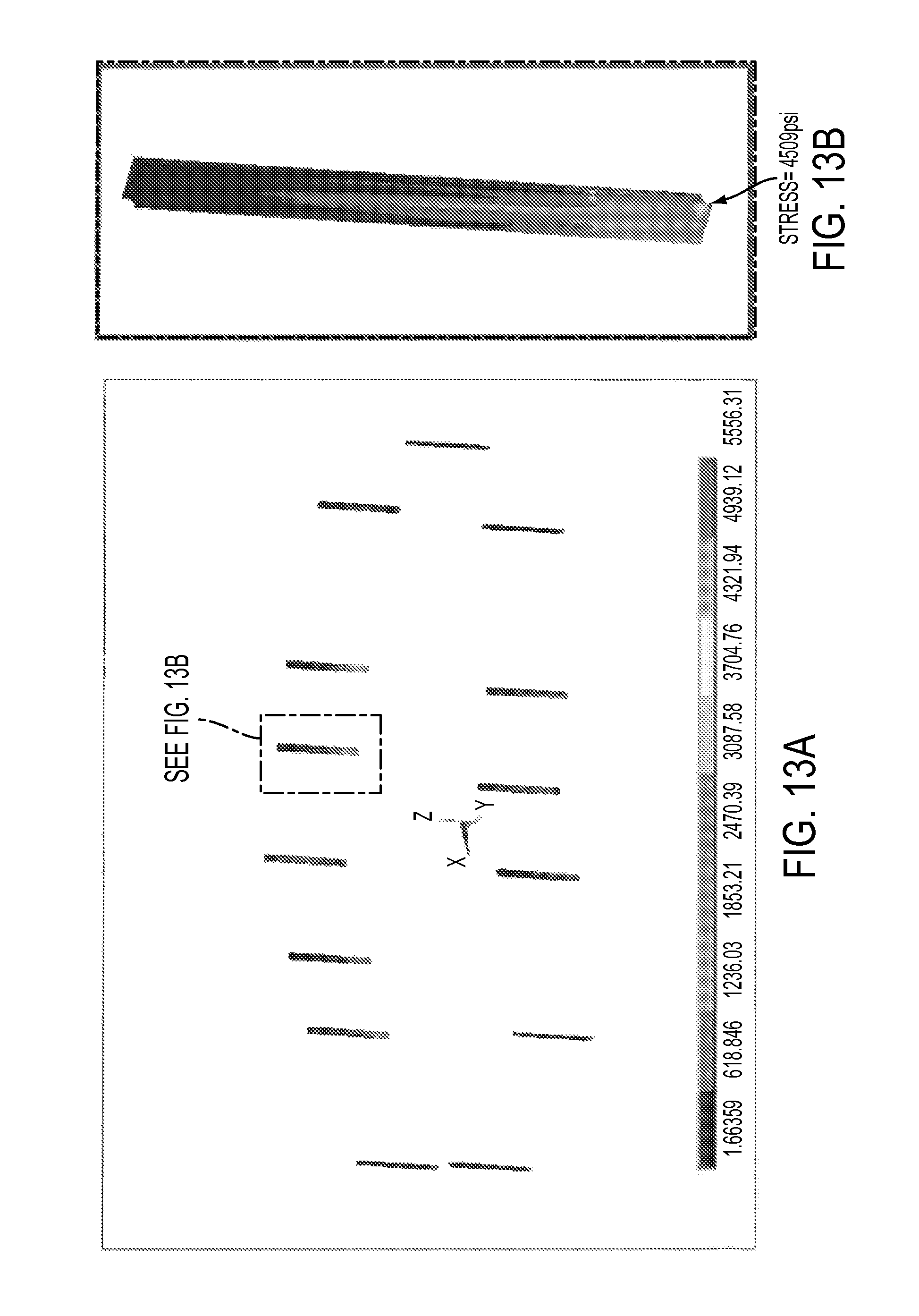
D00013

D00014
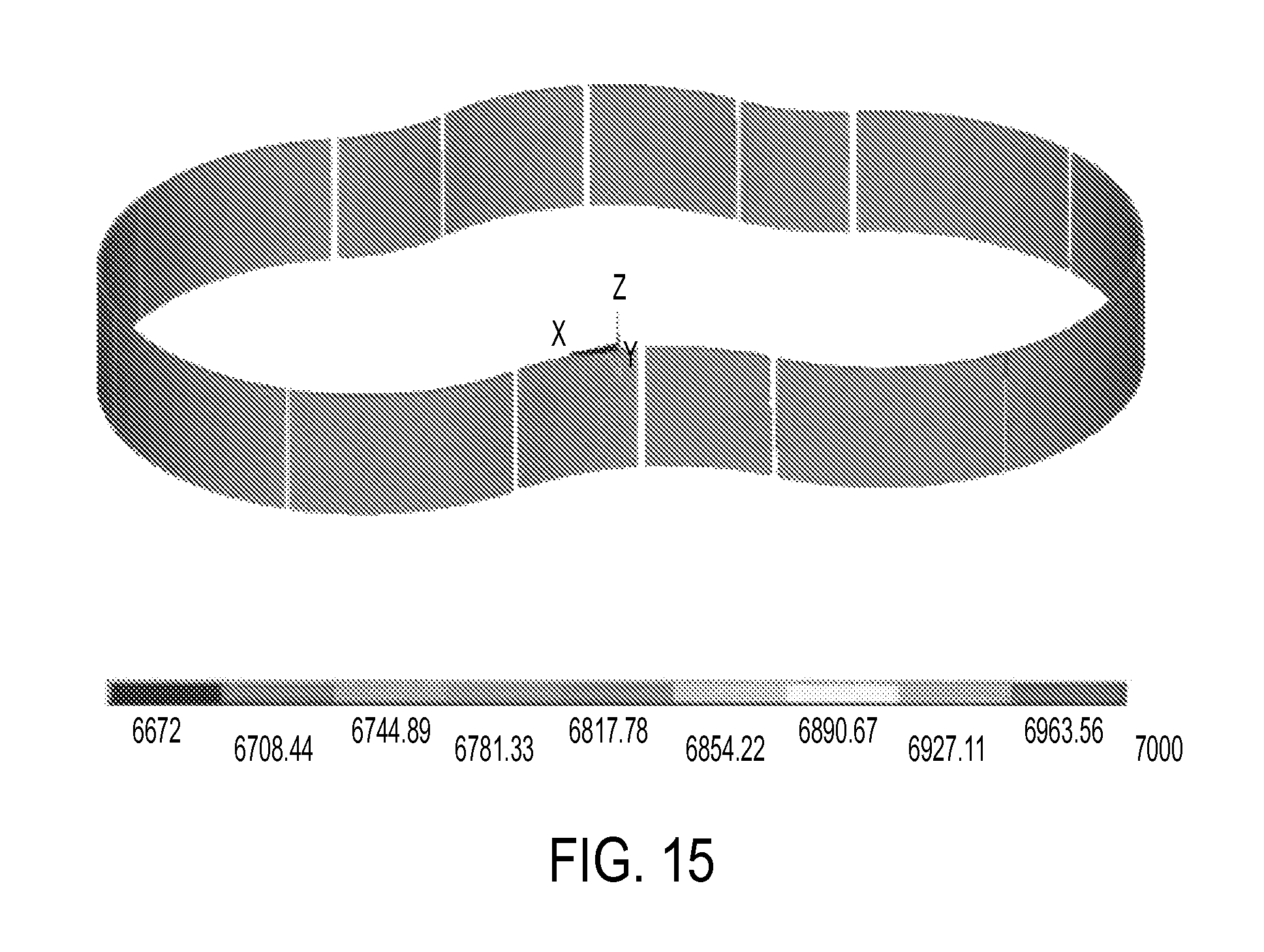
D00015
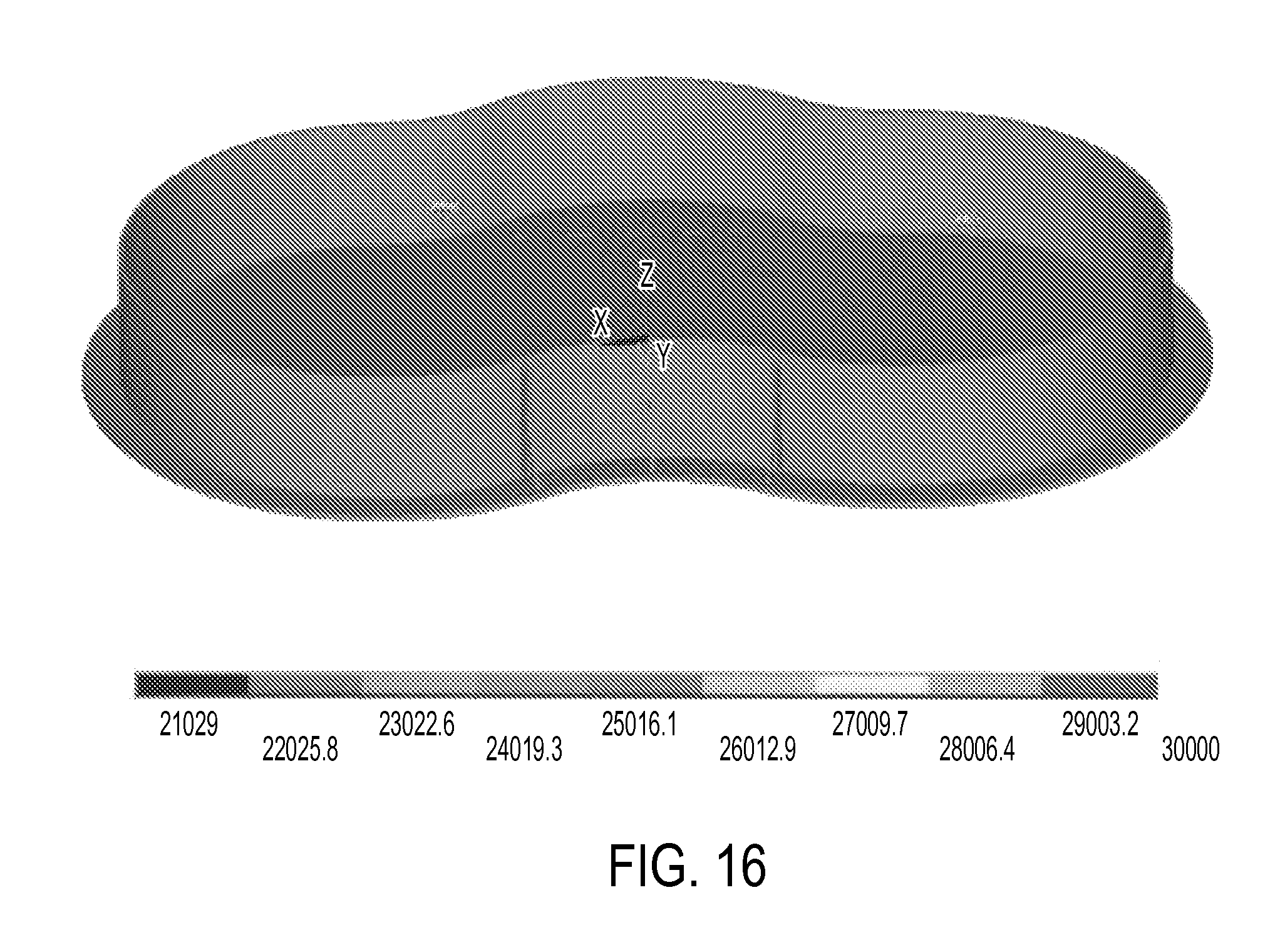
M00001

M00002

M00003

M00004

XML
uspto.report is an independent third-party trademark research tool that is not affiliated, endorsed, or sponsored by the United States Patent and Trademark Office (USPTO) or any other governmental organization. The information provided by uspto.report is based on publicly available data at the time of writing and is intended for informational purposes only.
While we strive to provide accurate and up-to-date information, we do not guarantee the accuracy, completeness, reliability, or suitability of the information displayed on this site. The use of this site is at your own risk. Any reliance you place on such information is therefore strictly at your own risk.
All official trademark data, including owner information, should be verified by visiting the official USPTO website at www.uspto.gov. This site is not intended to replace professional legal advice and should not be used as a substitute for consulting with a legal professional who is knowledgeable about trademark law.